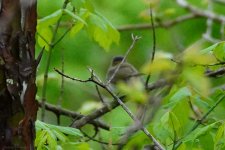MiddleRiver
Well-known member





ReV was suggested by one local club member. I thought it was distinctly chubbier and darker, and with a contrasting skullcap. We actually have a lot of ReV's right now and (when I can find them!) I'm often watching them. I typically see/hear them at mid-level trees. This bird was fairly low and in dense foilage, as you can tell by photo angle. At the time, my first reaction based on general impression was 'that's something new/different!'.Is there a chance this is Red-eyed Vireo at an odd angle?
I realize the image has limitations, but I think most Tennessee show at least a partial wing-bar. Red-eyed Vireo would certainly show such a plain, greenish wing. I think the apparent dull gray cap blending into green nape favors the vireo, too, since male Tennessee's gray cap tends to be more well-defined. The bill could be an issue, though if the bird is tilting its head towards the viewer then the hook and bulk of the bill could be hard to see.
Any chance of more photos, even blurry ones?

I consider that an entirely unsafe assessment in a photo of this quality. In fact they look black.legs . . . are blue-grey
Blue-grey for me even taking into account picture quality. Having said this, I don't think this is the vireo. It has a white vent (cf yellowish) and a short tail. I suspect the warbler's apparent leg colour will depend on lots of things like ambient light and may be variable like chiffchaffI consider that an entirely unsafe assessment in a photo of this quality. In fact they look black.




The legs appear quite stout and are blue-grey. This would favour Red-eyed Vireo, over Tennessee Warbler which has blackish legs.
Stu
The legs look blue-gray to me on my laptop monitor.I consider that an entirely unsafe assessment in a photo of this quality. In fact they look black.
yeah but it's in shadow...The toes look blue-grey, the tarsus (commonly called 'leg') looks black. A very clear colour distinction between those is apparent in this image.
